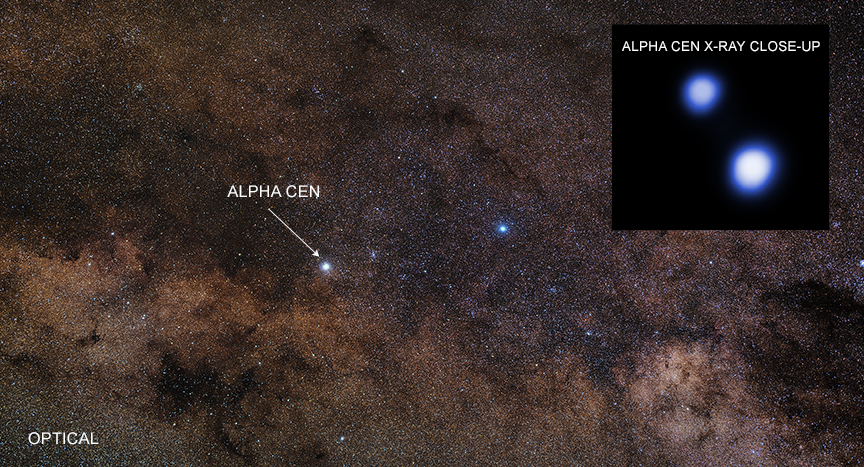Could Alien Life Handle the Radiation in 3-Star Alpha Centauri System?
Well, two out of three ain't bad.
The levels of X-ray radiation streaming from Alpha Centauri A and B — two of the three stars in the nearest solar system to our own — are comparable to those emitted by our own sun, according to a new study based on observations by NASA's Chandra X-ray Observatory.
"This is very good news for Alpha Cen AB in terms of the ability of possible life on any of their planets to survive radiation bouts from the stars," study lead author Tom Ayres, of the University of Colorado Boulder, said in a statement. "Chandra shows us that life should have a fighting chance on planets around either of these stars." [Mission to Alpha Centauri: Breakthrough Starshot in Pictures]
Alpha Centauri lies about 4.2 light-years from the sun. The three-star system consists of the close-orbiting A and B pair (which astronomers often lump together as "AB") and a far-flung companion called Proxima Centauri. A and B are sun-like stars, whereas Proxima Centauri is a small, dim red dwarf.

No planets have been confirmed around either Alpha Cen A or B, so all discussion of such worlds is strictly hypothetical. (Astronomers continue to look, however.)
Proxima Centauri hosts a roughly Earth-size planet, known as Proxima b, in the "habitable zone" —that range of distances from a star where liquid water could exist on a world's surface. But red dwarfs are incredibly active stars, frequently firing off superpowerful flares that can bathe orbiting worlds in punishing radiation. So, many scientists question the true habitability of Proxima b, speculating that any atmosphere it once had was stripped long ago by the activity of its host star.
But the radiation story is quite different for Alpha Cen AB, the new study reports. Chandra has been monitoring the two stars about once every six months since 2005, and Ayres dug into this data.
Get the Space.com Newsletter
Breaking space news, the latest updates on rocket launches, skywatching events and more!
He found that any habitable-zone planets that may exist around Alpha Cen A would receive lower X-ray doses than comparable worlds circling our own sun. Alpha Cen B's habitable-zone doses are about five times greater than those in our solar system — still not high enough to be a showstopper for life, Ayres said.
Ayres presented the new study on Wednesday (June 6) at the 232nd meeting of the American Astronomical Society meeting in Denver. Some of the results were published in January 2018, in the journal Research Notes of the American Astronomical Society.
Follow Mike Wall on Twitter @michaeldwall and Google+. Follow us @Spacedotcom, Facebook or Google+. Originally published on Space.com.
Join our Space Forums to keep talking space on the latest missions, night sky and more! And if you have a news tip, correction or comment, let us know at: community@space.com.

Michael Wall is a Senior Space Writer with Space.com and joined the team in 2010. He primarily covers exoplanets, spaceflight and military space, but has been known to dabble in the space art beat. His book about the search for alien life, "Out There," was published on Nov. 13, 2018. Before becoming a science writer, Michael worked as a herpetologist and wildlife biologist. He has a Ph.D. in evolutionary biology from the University of Sydney, Australia, a bachelor's degree from the University of Arizona, and a graduate certificate in science writing from the University of California, Santa Cruz. To find out what his latest project is, you can follow Michael on Twitter.









